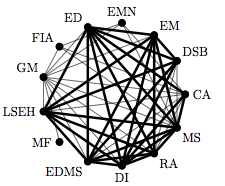Ok! Did Arron Swartz really say in his talk about Open Library what David Weinberger reports:
The first thing librarian argued about when they saw OL was what subject classification system to use. “We don’t have to choose on the Internet. We can store all the category systems and let people choose which ones they want.” Likewise with all the different identifiers, e.b., ISBN, OCLC numbers, OL identifiers. (“We have to make our own identifier system because we’re going to have more books.”)
Ferberization means connecting physical books to all the different abstractions, e.g., print runs, editions, translations, etc. The library world has focused primarily on the physical books on the shelves. “We’re going to have to come up with new ways of expressing the relationships,” including allowing people to create new relationships, e.g., this book is based on that one, this book refutes that one, this one replaces that one.
This is just outrageously funny! It’s perfect! I’m gobbsmacked. Oh, I hope that’s what he said!
For those who don’t know, Ferberization is a process for teaching a baby the skill of putting it’s self to sleep.
Don’t you just hate the way those damn books wake up at all hours demanding to be settled down again into their snug little categories?





